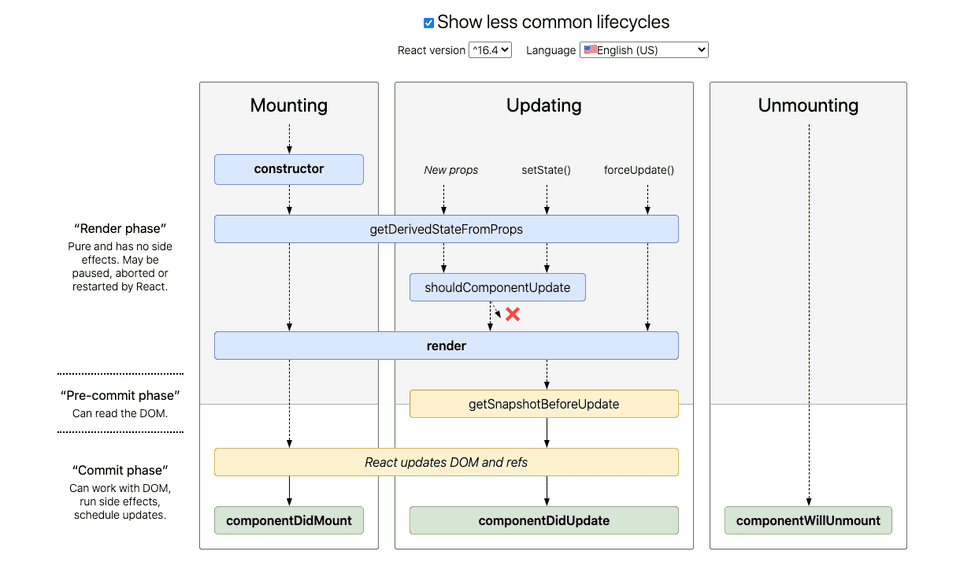React Lifecycle Methods và những thứ liên quan
Content table: Lifecycle có 3 giai đoạn chính
- Mounting
Giai đoạn từ lúc component được tạo ra đến khi đẩy vào DOM
- Updating
Một update khi state hay props thay đổi -> re-render
- static getDerivedStateFromProps(props, state)
- shouldComponentUpdate(nextProps, nextState)
- render()
- getSnapshotBeforeUpdate(prevProps, prevState)
- componentDidUpdate(prevProps, prevState, snapshot)
- Unmounting
Giai đoạn xoá component khỏi DOM
Support content:
componentDidCatch(error, info) và ErrorBoundary
Các cách compare Object trong JS
constructor(props)
Nếu không init state hoặc bind methods thì không cần constructor
Gọi super(props) thì mới xài được this trong hàm constructor()
// Error
class MyComponent extends React.Component {
constructor() {
console.log(this); // Reference Error
}
render() {
return <div>Hello {this.props.name}</div>;
}
}
// Good
class MyComponent extends React.Component {
constructor() {
super();
console.log(this); // this logged to console
}
render() {
return <div>Hello {this.props.name}</div>;
}
}Lý do:
Muốn sử dụng những tinh tuý của react thông qua this như this.props hay this.state trong MyComponent constructor() thì React.Component constructor() phải được chạy trước và hàm super() thực hiện điều đó. super() trong JS dùng để gọi constructor() của class cha và MyComponent extends React.Component.
Truyền props vào super() -> super(props) thì ở React.Component constructor() sẽ gán props đó vào this, sau đó có thể truy cập this.props ở phía dưới.
Vậy tại sao không có MyComponent constructor() vẫn xài được this như this.props hay this.state? Do ngoài MyComponent constructor() ra thì tất cả các hàm còn lại trong class MyComponent đều chạy sau React.Component constructor()
class MyComponent extends React.Component {
render() {
return <div>Hello {this.props.name}</div>;
}
}static getDerivedStateFromProps(props, state)
Well… Docs nói không nên dùng do sẽ làm code rậm rịt và khó hiểu. You Probably Don’t Need Derived State
getDerivedStateFromProps được dùng khi muốn update state khi props thay đổi, giống UNSAFE_componentWillReceiveProps(nextProps), khác ở chỗ vì getDerivedStateFromProps là static nên nó không truy cập được this của component.
Trong hàm là props mới truyền vào và state hiện tại, khi return thì return state mới, state có giá trị thì component sẽ re-render, return null sẽ không re-render
class EmailInput extends Component {
state = {
email: this.props.defaultEmail,
prevPropsUserID: this.props.userID,
};
static getDerivedStateFromProps(props, state) {
// Any time the current user changes,
// Reset any parts of state that are tied to that user.
// In this simple example, that's just the email.
if (props.userID !== state.prevPropsUserID) {
return {
prevPropsUserID: props.userID,
email: props.defaultEmail,
};
}
return null;
}
// ...
}render()
Là render đó, return trong các dạng jsx, array, fragments, portals, string, number, bolleans or null
Note: render sẽ không được gọi nếu shouldComponentUpdate return false
componentDidMount()
Chạy ngau sau khi component được mounted, được dùng để fetch dữ liệu remote.
Nên có state ban đầu ở hàm constructor (dữ liệu ban đầu để show ví dụ như "", 0, loading = true, [], {},…) để cho component có thứ để render lần đầu rùi ở componentDidMount sẽ fetch dữ liệu hay cập nhật dữ liệu rồi setState để render thêm một lần nữa.
Vì nếu fetch dữ liệu trước rùi setState, ví dụ ở hàm lifecycle UNSAFE_componentWillMount thì người dùng sẽ cảm thấy website chậm vì fetch data sẽ mất thời gian và trong lúc đó người dùng chả có gì để thấy và tương tác cả
componentDidMount() {
fetch("https://api.example.com/items")
.then(res => res.json())
.then(
(result) => {
this.setState({
isLoaded: true,
items: result.items
});
},
// Note: it's important to handle errors here
// instead of a catch() block so that we don't swallow
// exceptions from actual bugs in components.
(error) => {
this.setState({
isLoaded: true,
error
});
}
)
}shouldComponentUpdate(nextProps, nextState)
Như cái tên, return true nếu muốn component update, return false nếu không, default tất nhiên là true
Theo docs, chỉ nên dùng shouldComponentUpdate để tối ưu hiệu suất hơn là dựa vào nó để ngăn re-render
Vì react chỉ so sánh state và props theo kiểu Referential để quyết định có re-render hay không nên cả khi this.setState({a: this.state.a}) thì nó vẫn re-render
Cho nên muốn ngăn re-render thì có thể xài shouldComponentUpdate để tự viết Manual comparation nhưng tốt hơn thì dùng React.PureComponent, PureComponent sử dụng Shallow equality để so sánh state và props.
class App extends React.Component {
constructor() {
super();
this.state = {
d: 0,
};
}
shouldComponentUpdate(nextProps, nextState) {
if (nextState.d === this.state.d) {
return false;
}
return true;
}
componentDidUpdate() {
console.log("did");
}
render() {
return (
<div>
<h1>{this.state.d}</h1>
<button onClick={() => this.setState({ d: this.state.d + 1 })}>
button
</button>
</div>
);
}
}Nếu bỏ shouldComponentUpdate thì mỗi lần nhấn nút thì sẽ thấy log ‘did’ ra màn hình tức là bị re-render kể cả khi setState giá trị cũ
getSnapshotBeforeUpdate(prevProps, prevState)
Thằng này chạy trước khi update, trước render nên sẽ thích hợp nếu muốn lưu lại snapshot trước khi bị data mới đè lên khi render.
Return snapshot sẽ đưa snapshot đến componentDidUpdate
Một ví dụ giữ vị trí scoll khi push data mới vào màn hình
class ScrollingList extends React.Component {
constructor(props) {
super(props);
this.listRef = React.createRef();
}
getSnapshotBeforeUpdate(prevProps, prevState) {
// Are we adding new items to the list?
// Capture the scroll position so we can adjust scroll later.
if (prevProps.list.length < this.props.list.length) {
const list = this.listRef.current;
return list.scrollHeight - list.scrollTop;
}
return null;
}
componentDidUpdate(prevProps, prevState, snapshot) {
// If we have a snapshot value, we've just added new items.
// Adjust scroll so these new items don't push the old ones out of view.
// (snapshot here is the value returned from getSnapshotBeforeUpdate)
if (snapshot !== null) {
const list = this.listRef.current;
list.scrollTop = list.scrollHeight - snapshot;
}
}
render() {
return <div ref={this.listRef}>{/* ...contents... */}</div>;
}
}Element.scrollTop, Element.scrollHeight
componentDidUpdate(prevProps, prevState, snapshot)
Được gọi sau khi render, một nơi để thực hiện những request sau khi UI được render, ví dụ như auto save, update state nếu có props mới,… Nhưng nhớ đặt setState trong một điều kiện nào đó, nếu không thì sẽ bị infinite loop
componentDidUpdate(prevProps, prevState, snapshot) {
// Typical usage (don't forget to compare props):
if (this.props.userID !== prevProps.userID) {
this.fetchData(this.props.userID);
}
}Nếu có getSnapshotBeforeUpdate thì sẽ có snapshot truyền vào, không thì snapshot sẽ là undefined
Note: componentDidUpdate sẽ không được gọi nếu shouldComponentUpdate return false
componentWillUnmount()
Được chạy trước khi component unmount
Nên thực hiện những clean up trong hàm này, ví dụ như huỷ request, noti, unsubscribe…
Đừng setState trong đây vì component sẽ éo bao giờ re-render nữa
componentDidCatch(error, info) và ErrorBoundary
error: Là Error thrown ra đó :v
info: Object gồm componentStack chứa thông tin component error những component liên quan
Ví dụ một ErrorBoundary component
class ErrorBoundary extends React.Component {
constructor(props) {
super(props);
this.state = { hasError: false };
}
static getDerivedStateFromError(error) {
// Update state so the next render will show the fallback UI.
return { hasError: true };
}
componentDidCatch(error, info) {
// Example "componentStack":
// in ComponentThatThrows (created by App)
// in ErrorBoundary (created by App)
// in div (created by App)
// in App
logComponentStackToMyService(info.componentStack);
}
render() {
if (this.state.hasError) {
// You can render any custom fallback UI
return <h1>Something went wrong.</h1>;
}
return this.props.children;
}
}Hiểu hơn về setState
Gán thẳng this.state = {...} chỉ khi ở hàm constructor vì gán thẳng thì react sẽ không re-render, chỉ có setState mới trigger re-render
setState là một hàm bất đồng bộ (asynchronous)
// assuming this.state = { value: 0 }
this.setState({
value: 1,
});
console.log(this.state.value); // 0// assuming this.state = { value: 0 };
// this.state.value = 0
this.setState({ value: this.state.value + 1 });
// this.state.value = 0
this.setState({ value: this.state.value + 1 });
// this.state.value = 0
this.setState({ value: this.state.value + 1 });
// after all setState, this.state.value = 1Nó như this.setState({ value: 0 + 1 }) 3 lần
Vì setState là bất đồng bộ nên sau setState thì this.state.value chưa được update liền nên vẫn sẽ là giá trị cũ (là 0)
Nhưng nó có callback ở params sau
// assuming this.state = { value: 0 }
this.setState(
{value: 1},
() => console.log(this.state.value); // 1
);Param đầu của setState cũng có thể là một function, (state) => ({...}), ở đây state mà nó lấy là lúc chạy hàm đó nên state đó đã được update.
// assuming this.state = { value: 0 };
// this.state = { value: 0 };
this.setState((state) => ({ value: state.value + 1 })); // state.value = 0
// this.state = { value: 0 };
this.setState((state) => ({ value: state.value + 1 })); // state.value = 1
// this.state = { value: 0 };
this.setState((state) => ({ value: state.value + 1 })); // state.value = 2
// this.state = { value: 0 };
// after all setState, this.state.value = 3Các cách compare Object trong JS
- Referential equality
Chỉ so sánh ref của object, không quan tâm những thứ bên trong
const hero1 = {
name: "Batman",
};
const hero2 = {
name: "Batman",
};
hero1 === hero1; // => true
hero1 === hero2; // => false
hero1 == hero1; // => true
hero1 == hero2; // => false
Object.is(hero1, hero1); // => true
Object.is(hero1, hero2); // => false- Manual comparison
Tự tạo hàm so sánh
function isHeroEqual(object1, object2) {
return object1.name === object2.name;
}
const hero1 = {
name: "Batman",
};
const hero2 = {
name: "Batman",
};
const hero3 = {
name: "Joker",
};
isHeroEqual(hero1, hero2); // => true
isHeroEqual(hero1, hero3); // => false- Shallow equality
So sánh giá trị bên trong, chỉ so 1 level, nếu bên trong lại là object thì so theo cách Referential equality
function shallowEqual(object1, object2) {
const keys1 = Object.keys(object1);
const keys2 = Object.keys(object2);
if (keys1.length !== keys2.length) {
return false;
}
for (let key of keys1) {
if (object1[key] !== object2[key]) {
return false;
}
}
return true;
}- Deep equality
Y như shallow equality, chỉ nếu gặp object thì thay vì so theo Referential equality thì tiếp tục xem giá trị bên trong và so theo shallow equality
function deepEqual(object1, object2) {
const keys1 = Object.keys(object1);
const keys2 = Object.keys(object2);
if (keys1.length !== keys2.length) {
return false;
}
for (const key of keys1) {
const val1 = object1[key];
const val2 = object2[key];
const areObjects = isObject(val1) && isObject(val2);
if (
(areObjects && !deepEqual(val1, val2)) ||
(!areObjects && val1 !== val2)
) {
return false;
}
}
return true;
}
function isObject(object) {
return object != null && typeof object === "object";
}
